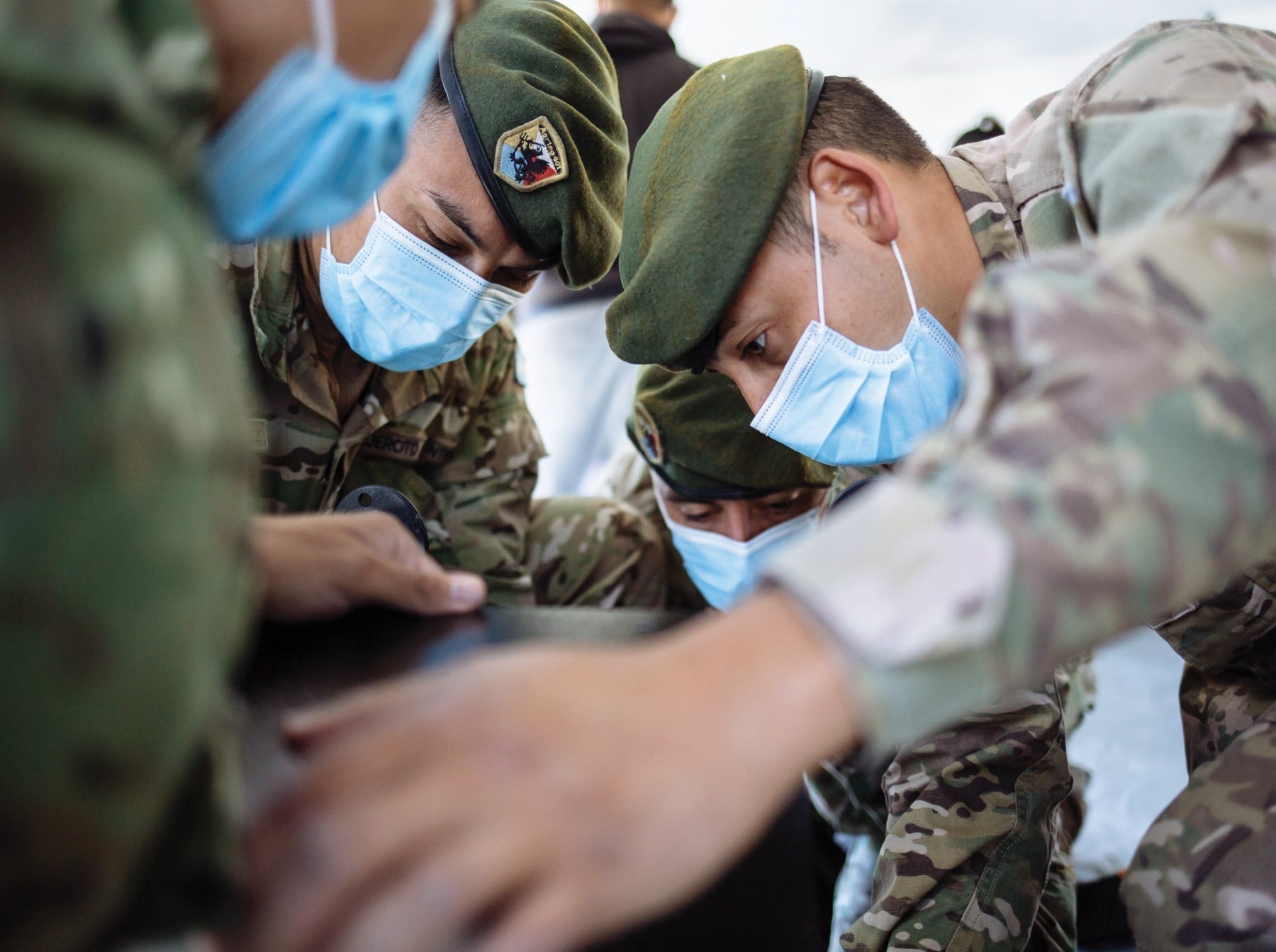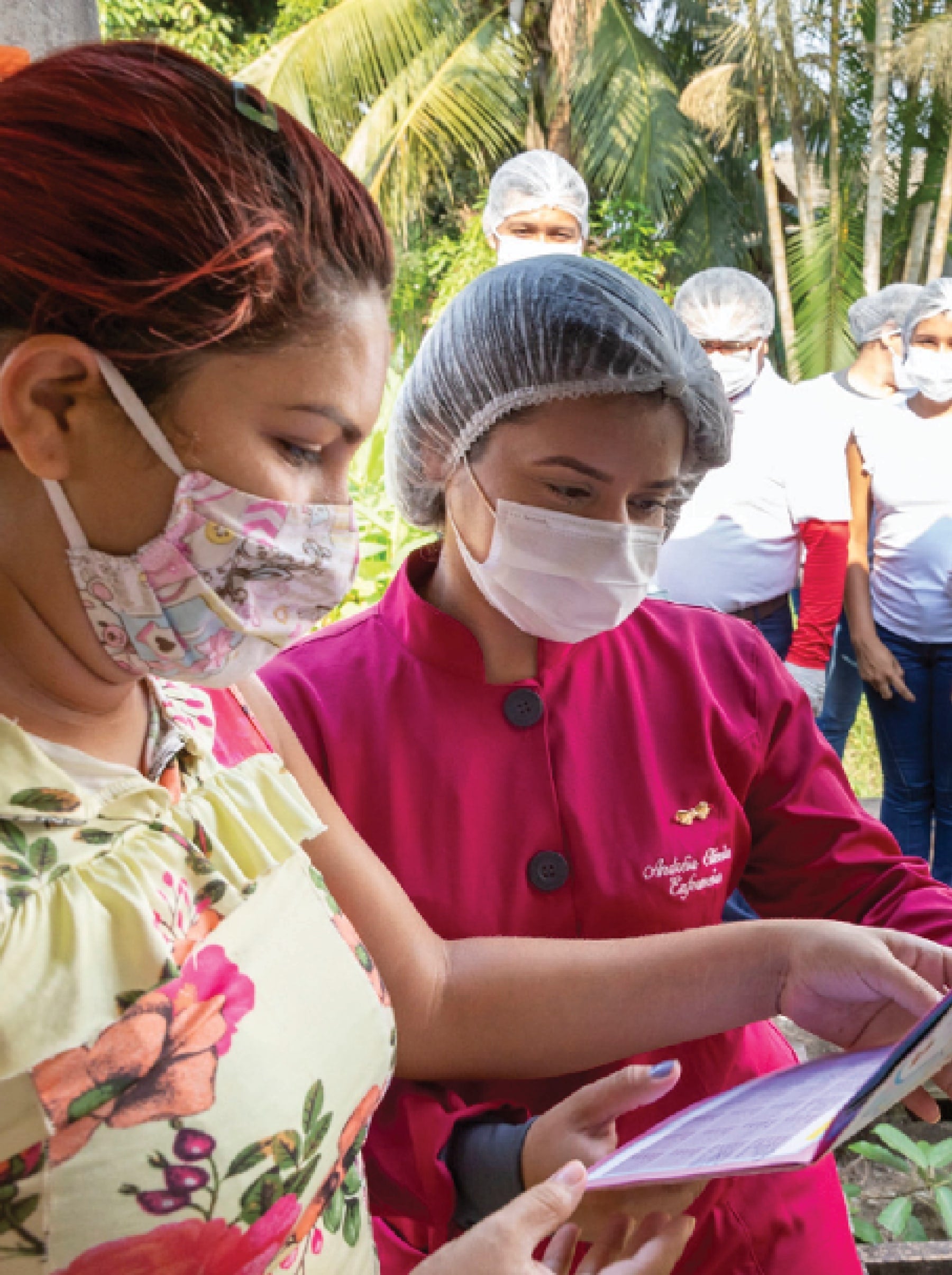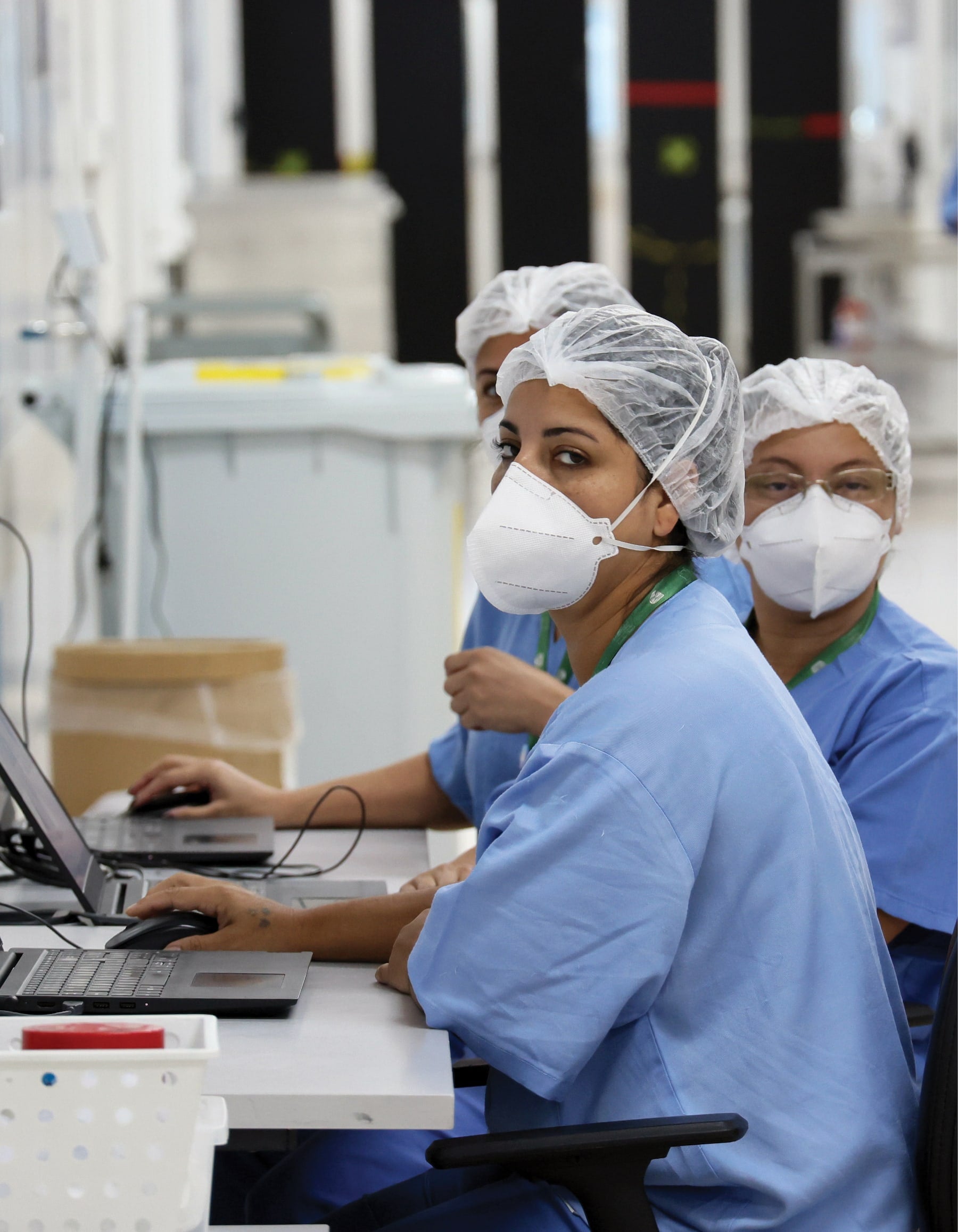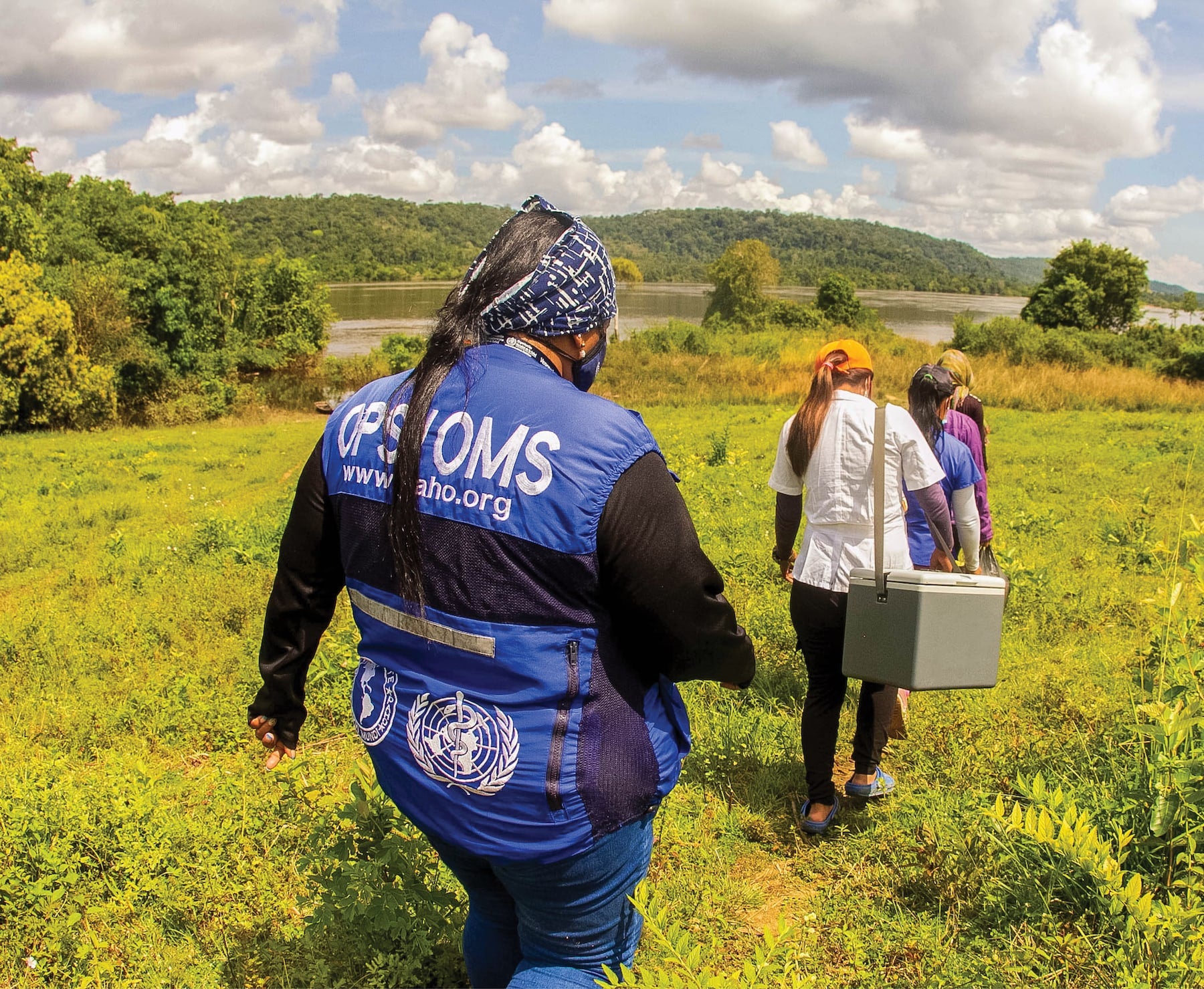Executive Summary
Pandemic Response and Recovery
The COVID-19 pandemic hit this Region particularly hard. Despite being home to only 8.4% of the world’s population, by March 2023, the Americas Region had recorded 25% of global COVID‑19 cases, and a shocking 43% of global COVID-19 deaths. As the pandemic has evolved, so too have the priorities of control efforts. The first year of the pandemic was focused on slowing transmission, managing cases and preventing deaths. In 2021, the huge regional vaccination drive took precedence, and the Pan American Health Organization (PAHO) had the opportunity to help Member States make solid progress toward global coverage targets. However, as 2022 got underway, the quick-wins that propelled the initial vaccination roll out were overtaken by more complicated implementation challenges, such as how to reach vulnerable groups with historically poor access to health services, how to address the challenges of migration and cross-border movements, and how to mitigate against the backslide in health indicators resulting from decreased access to other essential health services.
Since the start of the pandemic, PAHO’s response to COVID-19 has been grounded in the principles of engaging and empowering all of society and every arm of government through community-centered solutions, underpinned by the principles of equity and inclusiveness, with communities at the heart. The Organization’s unique capacity to forge multi-country partnerships, convene regional actors, and to collect data directly from countries has enabled us to maintain the momentum of the successful COVID‑19 response into its third full year and lay the foundation for the Region’s post-pandemic recovery.
This summary report of the 2022 COVID‑19 response shows that money invested in PAHO’s activities in the Region generates long-lasting benefits that go far beyond the initial direct results. The US Government’s generous contribution of US$ 75 million has been immeasurably valuable. Our task now is to capture the innovations that have underpinned our practical successes so that we can better support countries to create the strong and resilient health systems the Region needs for the future.
Implementation Context
A new wave of infections caused by the highly transmissible Omicron variant took case numbers to record heights in January 2022, and the variant continued to cause smaller surges as the year progressed. However, the lethality of COVID‑19 disease in the Region, as measured by the absolute number of deaths, dropped sharply: from 1.5 million in 2021 to just under 472 000 in 2022, a reduction of 68%. There was a corresponding decrease in the proportion of serious disease among diagnosed cases – an important signal that progress in expanding access to vaccination, combined with increases in natural immunity, was having a positive effect on the pandemic’s spread.
During this year, the broader damaging impacts COVID‑19 has had on health became more evident in indicators of health system function and health outcomes. Life expectancy, for example, is now known to have fallen from 75.1 years in 2019 to 72.2 years in 2021. And by the end of 2021, 93% of the countries in the Americas had reported disruptions in essential health services.
COVID-19 Response Highlights, January to December 2022
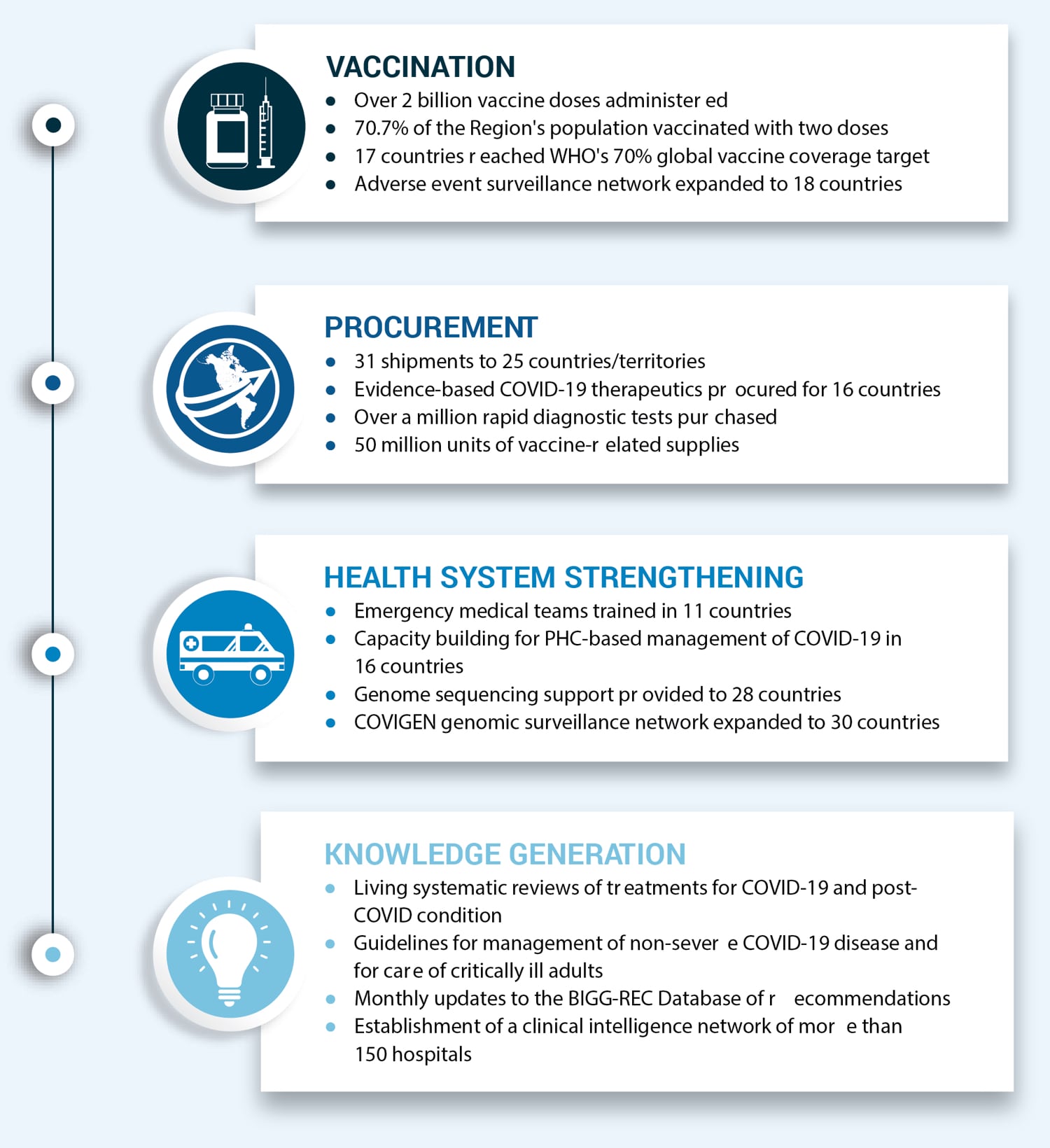
PAHO’s 2022 COVID‑19 response
In response to PAHO’s Regional COVID‑19 Response Strategy and Donor Appeal, the US Government, through the American Rescue Plan Act (ARPA), provided US$ 75 million to help countries in Latin America and the Caribbean continue to scale up their responses to the pandemic. The funding agreement included the following four main objectives:
- Objective 1: Accelerate widespread and equitable access to and delivery of safe and effective COVID‑19 vaccinations
- Objective 2: Reduce morbidity and mortality from COVID‑19, mitigate transmission, strengthen health systems, including to prevent, detect, and respond to pandemic threats
- Objective 3: Address acute needs driven by COVID‑19, mitigate household shocks,
and build resilience - Objective 4: Bolster economies and other critical systems under stress due to COVID‑19 to prevent backsliding and enable recovery
The activities and priorities selected to meet these objectives dovetail with PAHO’s integrated response plan and are fully aligned with the 2020, 2021, and 2022 WHO Strategic Preparedness and Response Plan for COVID‑19 as well as with PAHO Resolutions CD58.R9 (COVID‑19 Pandemic in the Region of the Americas) and CDSS1.R1 (Update on the COVID‑19 Pandemic in the Region of the Americas, COVAX Preparedness, and Equitable Access to COVID‑19 Vaccines), approved by Member States. The major programmatic areas of intervention were vaccination, procurements, health system strengthening, and generation of technical knowledge for informed decision-making.
Vaccination Roll-out
The COVID‑19 vaccination campaign is the largest vaccination drive in history. While the rapid expansion of coverage during 2021 had markedly slowed by the beginning of 2022, this year more time and resources were devoted to understanding the barriers to vaccination among different population groups, to address heterogeneity in coverage rates within and between countries and increase vaccine uptake. With US Government funds, PAHO was able to provide technical support to 33 countries/territories for: vaccination operations, pro-vaccination communications campaigns, expansion of cold chain networks, increasing manufacturing capacity, and providing internationally recognized vaccination certifications to cross-border travelers. As of 31 December 2022, 2.09 billion COVID‑19 vaccine doses had been administered in the Americas, compared to 1.48 billion at the start of the year. The previously established post-market regional surveillance network for the enhanced detection, notification, and investigation of potential adverse events, known as Events Supposedly Attributable to Vaccination or Immunization (ESAVI), was expanded to 18 countries during 2022.
Procurements
Direct procurement, distribution, and delivery of critical supplies is one of the most transformative interventions PAHO has been able to provide thanks to US Government funding. These purchases allow countries to have timely access to COVID‑19 supplies, while releasing financial resources for urgent needs besides the pandemic. Prior to 2022, PAHO’s Revolving Fund was able to support the acquisition of sufficient quantities of vaccines through the COVAX Facility to meet the Region’s needs, so during 2022, procurement focused on supplies to support vaccine distribution and administration. In total, 50 million units of supplies – including over 10 million syringes, 156 000 diluent (vials), and 220 000 safety boxes for storage of needles and syringes – were purchased and distributed, amounting to a total of 31 shipments to 25 countries/ territories.
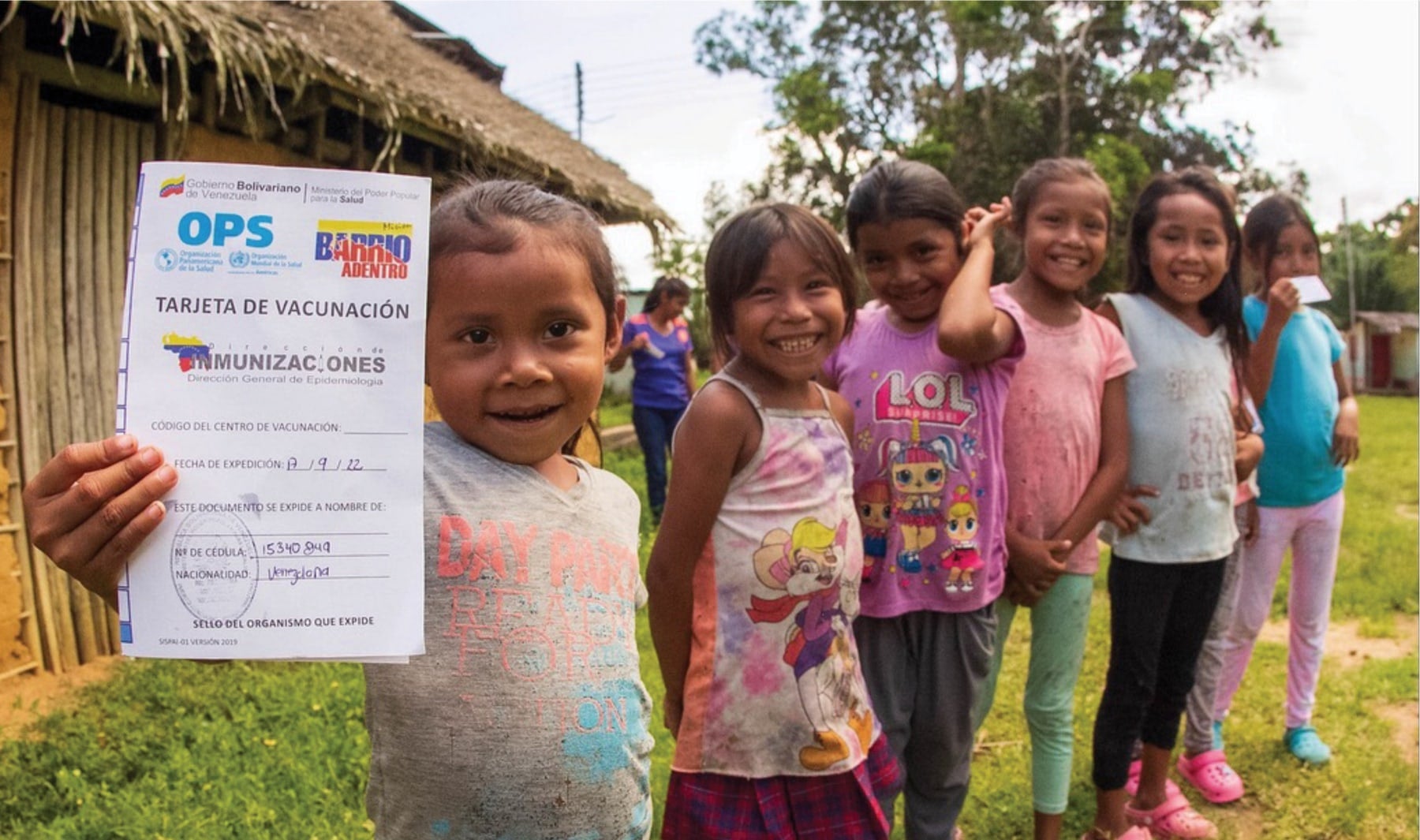
Children from a community along the Orinoco river in the Venezuelan Amazon display their vaccination certificates, September 2022 ©PAHO/WHO
Health System Strengthening
Primary health care (PHC) clinics and staff in all countries are at the frontlines of pandemic response. It was therefore an important priority for PAHO to help these front-line workers and facilities adapt to provide clinical care for patients with COVID‑19 disease, restore essential health services disrupted by the pandemic, and improve resilience against future threats. Our health system strengthening interventions focused on: increasing surge capacity, developing skills for management of patients with COVID‑19 and post-COVID conditions, improving laboratory and surveillance capacity, expanding access to technology and telemedicine, and strengthening social protection systems to incorporate an expanded vision of PHC-based service provision.
Technical Analysis and Knowledge Products
The COVID‑19 pandemic laid bare the interdependence of information, communication, and public health. One of PAHO’s major strengths is its ability to link implementation expertise and knowledge-based technical work, which facilitates the continuous review and revision of priorities and activity-planning to ensure optimal outcomes. US Government funds supported PAHO to produce 175 COVID‑19‑related publications during 2022, including systematic reviews, guidelines and clinical management advice, health systems analysis, and advice on all aspects of COVID‑19 response planning. PAHO’s technical experts also wrote or coauthored numerous studies published in scientific journals with regional or global reach.
Broad health system impacts
Unfortunately, COVID‑19 hit this Region at a time when many important health trends were already moving in the wrong direction. As the pandemic has progressed, these underlying challenges have not been resolved. For this reason, a crucial component of PAHO’s COVID‑19 response has been directed toward preventing further backsliding on key health outcomes and ensuring that emergency response capacity does not come at the expense of routine service provision. To address some of the broad public health impacts of the pandemic, PAHO has invested in interventions to: address the Region’s mental health crisis, tackle existing barriers to health service access, improve human resource shortages and skills deficits, and resolve challenges related to inadequate supplies and equipment. Particularly urgent concerns at this time are the drops in coverage rates for childhood vaccinations, which are now at their lowest point in 10 years, and increasing trends in incidence of some communicable diseases, including tuberculosis, HIV, syphilis, and outbreaks of arboviral diseases such as dengue, chikungunya, and Zika.
Conclusions
The COVID‑19 pandemic has not only been devastating for its immediate impacts. It also provoked a crisis in public health in the Region. Mitigation of the myriad consequences, which are only now becoming clear, requires a tremendous coordinated effort that rivals the pandemic response in scope.
PAHO is committed to supporting Member States not only to end the pandemic but also to strengthen public health and response capacity across the Region as an integral part of the post-pandemic recovery. In line with the publicized priorities of the new PAHO Director, PAHO will maintain a particular focus on strengthening primary-level health care as the foundation of health system resilience. Accelerating the roll out of the landmark renewal of the Essential Public Health Functions is a core part of this work. This comprehensive public health revival initiative intends to boost leadership, stewardship, and governance, improve policy, regulatory capacity, human resources, financing, monitoring, evaluation, and accountability across the board, among many other targeted interventions to address long-standing public health challenges.
However, as the focus of countries’ attention shifts away from emergency response and toward recovery and rebuilding, it is important that we do not leave the job of ending the pandemic undone. As our successful third year of response has shown, we have all the tools we need to end the COVID‑19 emergency: surveillance, vaccination, and information. By achieving this goal, we will gain an immeasurably valuable understanding of the health system gaps, access barriers, and systemic weaknesses that undermine current efforts to achieve universal health coverage. That knowledge will serve the Region well as it moves toward future health system resilience and better health outcomes.
